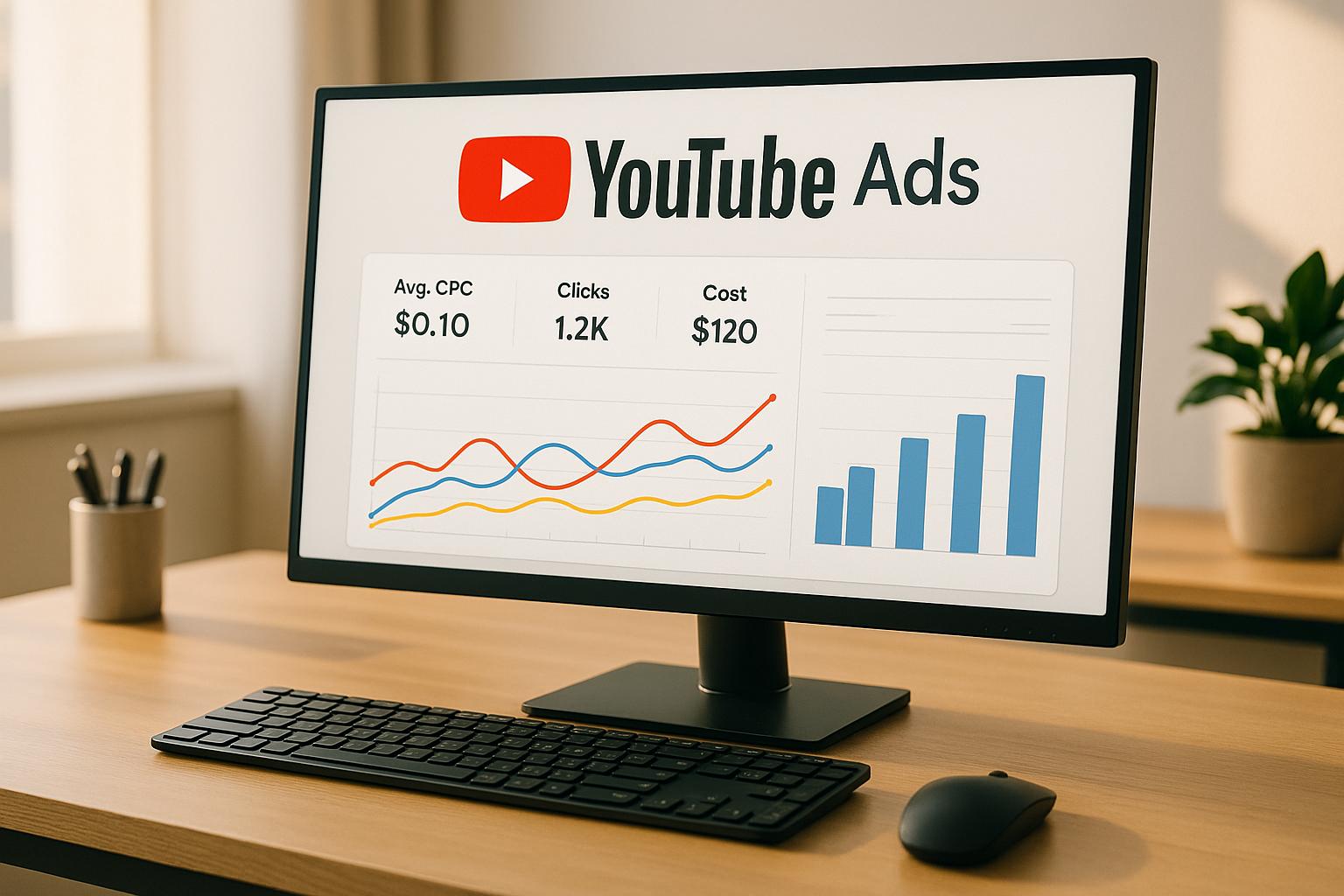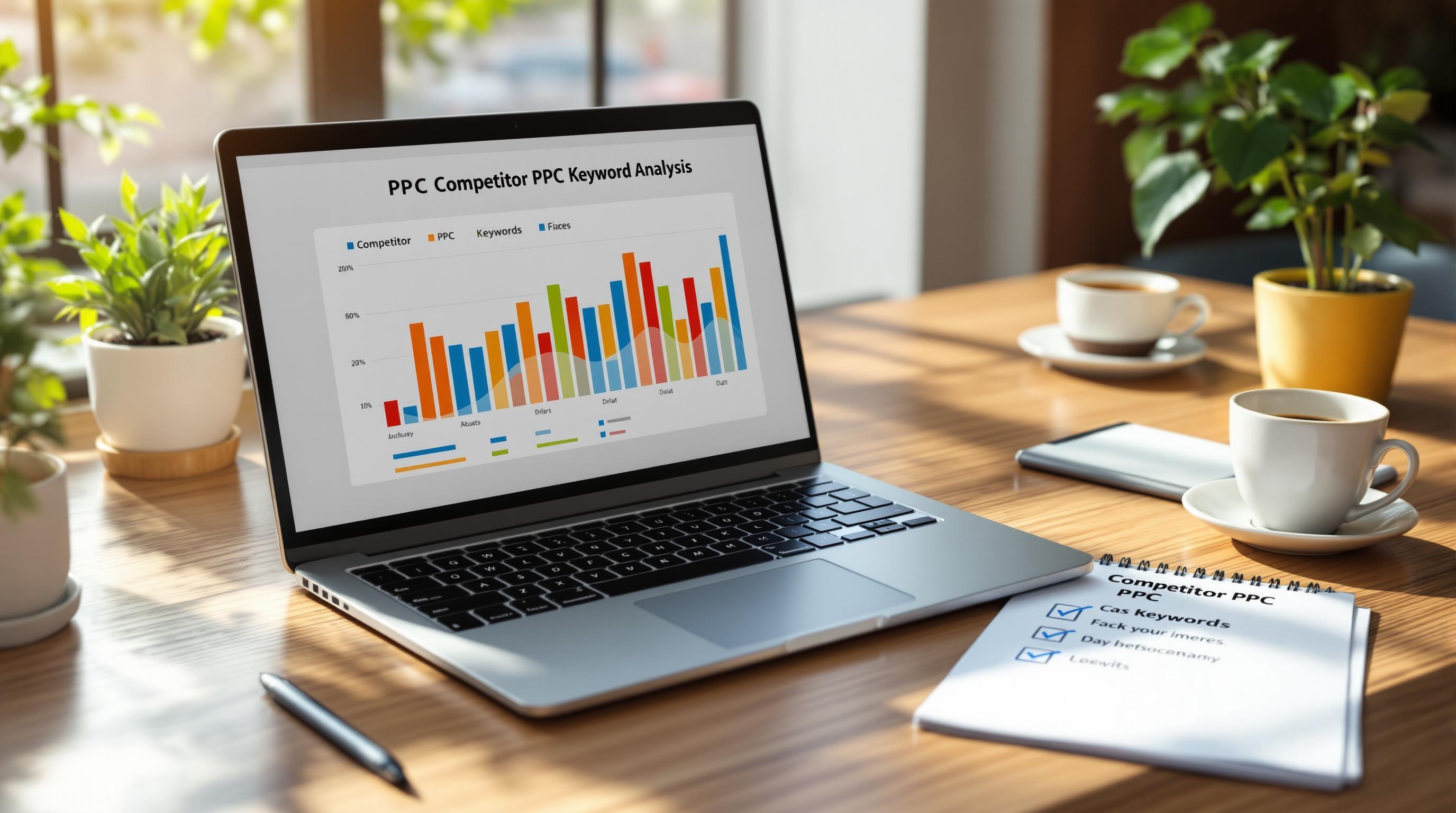Reinforcement learning (RL) is reshaping how advertisers manage pay-per-click (PPC) bids. Unlike traditional methods that rely on static data and predefined rules, RL uses real-time feedback to refine bidding strategies continuously. Here's the key takeaway: RL algorithms analyze auction environments, place bids, and learn from outcomes to maximize long-term return on ad spend (ROAS). This process happens in milliseconds, enabling smarter, more responsive bidding decisions.
Key Points:
- What RL Does: Learns through trial and error, optimizing bids based on auction results, user behavior, and campaign performance.
- How It Works: RL agents interact with dynamic ad environments, making decisions that are guided by feedback (rewards).
- Why It’s Effective: Processes real-time data, adapts to competition, and focuses on long-term goals rather than short-term wins.
- Challenges: Requires high-quality data, computational power, and carefully designed reward systems.
RL brings automation and precision to PPC campaigns, helping advertisers make data-driven decisions faster than ever before. However, successful implementation depends on robust infrastructure, clear business goals, and expert oversight.
Deep Reinforcement Learning for Sponsored Search Real-time Bidding
Core Components of Reinforcement Learning for Bid Adjustment
To understand how reinforcement learning (RL) operates in bid management, it’s essential to break down the key elements that enable dynamic bid adjustments. These components work together to refine and optimize bidding strategies over time.
Agent-Environment Interaction
At the center of any RL system is the interaction between the agent (your bidding algorithm) and its environment (the ad auction ecosystem). This interaction is what drives the entire learning and decision-making process for bid adjustments.
The agent acts as the decision-maker. It continuously analyzes data to determine the best bid for each auction opportunity, learning from past experiences to improve its strategy.
The environment includes everything the agent interacts with: ad exchanges, competitor bidding behaviors, user activity, and market conditions. This environment is highly dynamic, with auctions happening in real time across multiple platforms and audience segments.
- Actions are the bid amounts the agent decides for each auction. For example, it might bid $2.50 for one impression and $0.75 for another, depending on variables like audience value, time of day, and historical performance.
- States represent the current context, including campaign performance, remaining budget, competitor activity, user demographics, device types, and geographic locations. These states provide the agent with the information needed to make informed bidding decisions.
- Rewards are the feedback signals that tell the agent how successful its actions were. Rewards could include metrics like conversions, click-through rates, cost-per-acquisition improvements, or revenue generated. These signals help the agent identify which strategies yield better outcomes.
This interaction follows a continuous cycle: the agent observes the current state, takes an action (places a bid), receives a reward based on the result, and uses that feedback to refine future decisions. Over time, this iterative process leads to more effective and nuanced bidding strategies.
Required Data Inputs
For RL to work effectively in bid management, it relies on a range of data inputs - both historical and real-time - to guide decision-making.
- Historical and real-time auction data provide the foundation for strategy development. This includes bid amounts, auction outcomes, click-through rates, available inventory, estimated competition levels, and user characteristics. Since auction environments change rapidly, even a few seconds’ delay in data can impact performance.
- Budget and pacing information guides the agent in aligning its bidding strategy with financial and timeline constraints. For instance, if only 20% of the budget has been spent halfway through the month, the agent might need to increase bids to meet targets. On the other hand, if the budget is nearly exhausted early, the agent may adopt a more conservative approach.
- Conversion tracking data connects bidding decisions to real business results. Beyond immediate conversions, this includes view-through conversions, assisted conversions, and lifetime value metrics. The more accurately the agent can align bids with meaningful outcomes, the better.
- Competitive intelligence helps the agent understand the broader auction landscape. While exact competitor bids remain unknown, data like win rates, average auction prices, and impression shares provide valuable insights into market dynamics.
- External factors such as seasonality, economic conditions, and industry trends can also influence performance. RL systems that incorporate these broader signals often perform better than those focused solely on internal campaign metrics.
Without accurate and timely data, the agent’s decisions can falter. Comprehensive and high-quality data is what enables real-time optimization and drives better results.
How RL Algorithms Adjust Bids in Real Time
Reinforcement learning (RL) algorithms bring a dynamic edge to bidding strategies, enabling them to make fast decisions across countless auctions. Unlike traditional systems that rely on fixed rules, RL algorithms adjust their strategies based on actual outcomes, making them a perfect fit for the ever-changing world of PPC campaigns.
Step-by-Step Decision-Making Process
When an auction opportunity appears, the RL algorithm immediately evaluates the context. It considers factors like user demographics, device type, location, time of day, budget status, and recent campaign performance.
Using historical data and its learned policy, the algorithm selects the best bid for the situation. It factors in trends like peak conversion times, while also accounting for broader goals, such as staying within budget or responding to competitive pressures. For example, if a campaign isn't spending enough, the algorithm might slightly raise bids to increase ad delivery.
Once the auction concludes, the algorithm processes feedback - whether it won or lost, the clearing price, and user interactions - to fine-tune future decisions.
It then evaluates the results by comparing the bid's outcome with campaign goals. Positive results, like conversions, are rewarded, while poor outcomes are flagged for adjustments. This feedback loop ensures the strategy evolves over time, balancing proven methods with new approaches to keep improving performance.
This entire process happens in rapid cycles, allowing the algorithm to constantly refine its bidding strategy.
Ongoing Learning Loop
At the heart of RL is continuous learning, where every auction result becomes a building block for smarter bidding. Instead of relying on static rules that need manual updates, RL algorithms evolve by learning from each auction's outcome.
Each result - whether a success or failure - teaches the algorithm something new about how to bid more effectively. For instance, it might discover that small bid increases during high-traffic periods lead to better conversion rates and incorporate that insight into its strategy.
This learning happens incrementally, with recent results often carrying more weight. This allows the algorithm to quickly adapt to changing market conditions, staying relevant and competitive.
What sets RL apart is its focus on long-term success. It’s not just about winning a single auction or minimizing costs in the short term. The algorithm might accept a slightly higher cost per click if it means gaining valuable audience insights or boosting conversions in the long run. Over time, as more data is collected, campaigns can see noticeable improvements in both cost efficiency and overall performance.
sbb-itb-89b8f36
Benefits and Drawbacks of RL-Based Bid Adjustment
Reinforcement learning (RL) introduces a dynamic approach to managing PPC bids, offering significant advantages while also presenting some notable hurdles. Its ability to adapt and optimize in real-time makes it a powerful tool, but it’s not without its challenges.
One of RL's standout features is its ability to learn directly from campaign performance without relying on extensive labeled datasets. This allows for immediate bid adjustments and ongoing refinement over time. RL thrives in handling the complexities of PPC auctions, factoring in variables like audience behavior, competition, and timing - all in real time.
However, implementing RL systems comes with steep requirements. They demand substantial computational resources, specialized expertise, and constant oversight - particularly during the early stages when the system’s learning process can be unpredictable. Additionally, campaigns that lack consistent, high-quality data may struggle to achieve optimal results.
Comparison Table: Benefits vs. Drawbacks
| Benefits | Drawbacks |
|---|---|
| Real-time adaptation – Instantly adjusts bids based on market shifts and user behavior | High computational requirements – Requires significant processing power and infrastructure |
| Automation – Reduces manual effort and the risk of human error | Implementation complexity – Needs expert knowledge and time-intensive setup |
| Multi-variable processing – Analyzes audience, timing, competition, and budget interactions simultaneously | Unpredictable learning phase – Performance can fluctuate during initial training |
| Experience-based learning – Learns directly from campaign data without pre-labeling | Data dependency – Relies on consistent, high-quality data to perform well |
| Continuous improvement – Performance improves as more data is gathered | Reward function complexity – Designing metrics that align with business goals can be challenging |
One of the most critical aspects of RL implementation is designing the reward function. This function defines the algorithm’s success criteria, and balancing multiple campaign goals - like maximizing conversions while controlling costs - requires both technical expertise and a deep understanding of business priorities. Crafting an effective reward system is no small feat, often demanding significant computational resources and careful planning.
Despite these obstacles, RL-based bid adjustment has the potential to significantly enhance cost efficiency and campaign performance when implemented correctly. The success of this approach hinges on ensuring your campaign volume, technical capabilities, and business objectives align with RL’s demanding requirements.
Next, let’s dive into what it takes to implement RL in PPC campaigns effectively.
Implementation Requirements for RL in PPC Campaigns
To effectively integrate reinforcement learning (RL) into pay-per-click (PPC) campaigns, businesses need to prepare both technically and operationally. RL algorithms, known for their ability to adjust bids in real time, demand a well-thought-out strategy and robust infrastructure. Without meeting these essential requirements, achieving meaningful results can be a challenge.
Prerequisites for RL Deployment
Data Infrastructure and Quality
Data is the backbone of any RL system. To ensure success, your campaign data should include a broad range of metrics: historical keywords, bids, audience profiles, ad copy, landing pages, conversions, click-through rates, conversion rates, ad quality scores, user segments, time-of-day performance, device types, and ad categories. This comprehensive dataset must also account for dynamic factors like market trends, competitive shifts, and user behavior changes.
High-quality data is non-negotiable. It must be accurate, complete, and consistent, with enough volume to represent the full scope of your advertising environment.
Technical Infrastructure Requirements
RL systems come with hefty computational demands. To manage real-time analysis and adjust bids across thousands of keywords, you'll need powerful processing capabilities. Additionally, your infrastructure must handle continuous data preprocessing - like normalization and scaling - to convert raw campaign data into a format suitable for RL systems.
Integration is another critical factor. Your RL system should seamlessly connect with major advertising platforms via APIs and real-time data feeds, allowing it to implement bid adjustments quickly based on algorithmic decisions.
Reward Function Design
Reward functions are the compass guiding your RL system. They need to reflect your core business goals, whether that's maximizing return on ad spend (ROAS), optimizing click value relative to bid costs, or achieving long-term ROI targets. By clearly defining these objectives, you help the algorithm understand what "success" looks like for your campaigns.
Ongoing Monitoring and Feedback Systems
RL systems require constant oversight, particularly during the learning phase when performance can fluctuate. Regular updates with fresh data and feedback are essential for the system to adapt and improve over time. This process often calls for personnel who are well-versed in both RL technology and your specific business objectives. Effective monitoring ensures the system stays aligned with your goals and transitions smoothly into the next phase of optimization.
Using Specialized Tools and Directories
Once the foundational requirements are met, businesses can streamline RL implementation by collaborating with experts. Given the complexity of RL, many companies find success by partnering with specialized agencies or leveraging advanced bid management tools. The Top PPC Marketing Directory is a great resource for identifying these experts.
This directory connects businesses with partners who have proven expertise in algorithm-driven bid and campaign management. These professionals can guide you through every step, from preparing your data to fine-tuning the system for optimal performance.
When choosing a partner, prioritize those with a strong track record in performance tracking and programmatic advertising. Their experience with data-intensive, automated systems will be invaluable. Many agencies also offer A/B testing services to compare RL-driven strategies with your current bidding methods, ensuring that the transition delivers measurable improvements.
Conclusion
The discussion above highlights how reinforcement learning (RL) is reshaping PPC bid management. By using continuous streams of data - ranging from historical trends to live metrics like click-through rates and conversions - RL adjusts bids in real time. This approach taps into audience behavior patterns and competitive dynamics to fine-tune bidding strategies for better outcomes.
What makes RL stand out is its ability to constantly evaluate performance and adapt strategies on the fly. This means campaigns can respond instantly to shifts in market conditions or user behavior, eliminating the need for constant manual adjustments. It’s a dynamic, data-driven process that keeps campaigns competitive and efficient.
While RL offers clear benefits, like improving ROI, reducing manual effort, and boosting campaign performance, it’s not without its hurdles. The technology requires a robust data infrastructure, significant computational power, and carefully crafted reward functions. Additionally, businesses may face challenges during the initial learning phase, where performance can fluctuate as the system calibrates itself.
To succeed with RL, businesses need the right tools and expertise. High-quality data systems, effective monitoring, and expert guidance are crucial. For those looking to navigate this complex landscape, the Top PPC Marketing Directory is a helpful resource. It connects advertisers with agencies and tools specializing in RL-driven bidding strategies. These experts can assist at every stage - from data preparation and integration to ongoing optimization - ensuring RL delivers measurable improvements in campaign performance.
FAQs
How is reinforcement learning different from traditional methods for managing PPC bids?
Reinforcement learning (RL) offers a dynamic way to handle PPC bids by learning directly from live auction feedback. Instead of sticking to fixed rules, RL uses trial and error to continuously tweak bids, aiming to improve key metrics like conversions or click-through rates in real time.
On the other hand, traditional bid management depends on static rules, historical data, or pre-set algorithms. While these methods work well in stable conditions, they can't match RL's ability to adapt instantly to shifting auction dynamics. This gives RL a clear edge when it comes to boosting campaign performance.
What data is needed to use reinforcement learning for adjusting bids effectively?
To apply reinforcement learning for bid adjustments, you’ll need three key elements: real-time interaction data, a comprehensive understanding of the current environment, and well-defined reward signals. Real-time data enables the algorithm to make quick, informed decisions, while a detailed model of the environment ensures it can interpret the context behind each bid. Reward signals serve as the system’s compass, steering it toward goals like boosting ROI or driving more conversions.
When real-world data is scarce, simulations can act as a training ground for the algorithm. However, ongoing data collection remains essential for improving its performance over time.
What challenges can businesses face when using reinforcement learning for PPC campaigns, and how can they overcome them?
Integrating reinforcement learning (RL) into PPC campaigns isn't always straightforward. It comes with hurdles like overestimating bid values, keeping up with shifts in user behavior, and staying within budget limits. If these challenges aren't handled well, they can lead to wasted resources and missed opportunities.
To tackle these issues, businesses should start by clearly defining their campaign goals. Choosing RL algorithms that fit their specific needs is also key, along with fine-tuning parameters to boost results. Regularly reviewing the model's outputs helps ensure that bids remain on track with both the budget and campaign objectives. For smaller businesses, taking a step-by-step approach to adopting RL can help keep costs and resource demands manageable.


